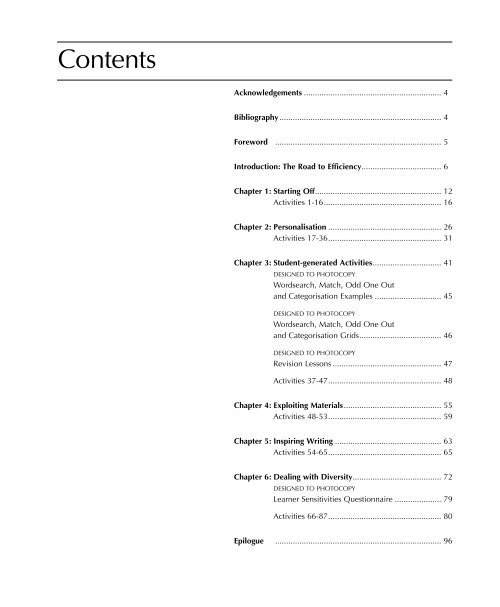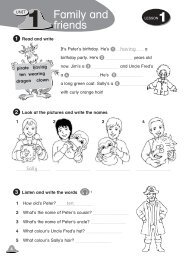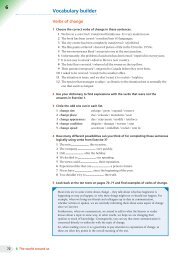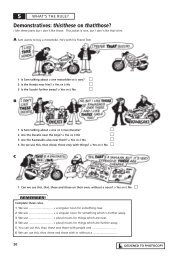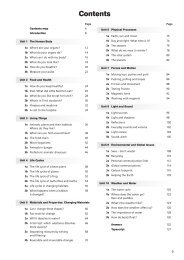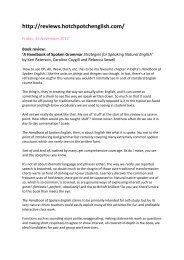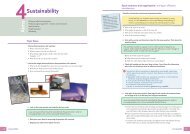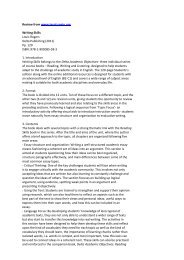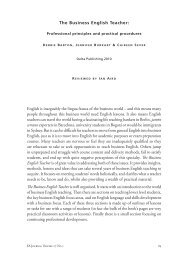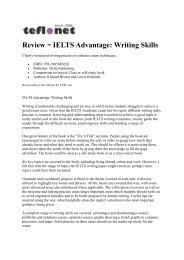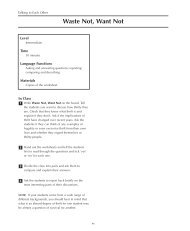MinimaxTeacher_p3-11.. - Delta Publishing
MinimaxTeacher_p3-11.. - Delta Publishing
MinimaxTeacher_p3-11.. - Delta Publishing
Create successful ePaper yourself
Turn your PDF publications into a flip-book with our unique Google optimized e-Paper software.
Contents<br />
Acknowledgements .............................................................. 4<br />
Bibliography......................................................................... 4<br />
Foreword ........................................................................... 5<br />
Introduction: The Road to Efficiency.................................... 6<br />
Chapter 1: Starting Off......................................................... 12<br />
Activities 1-16..................................................... 16<br />
Chapter 2: Personalisation ................................................... 26<br />
Activities 17-36................................................... 31<br />
Chapter 3: Student-generated Activities............................... 41<br />
DESIGNED TO PHOTOCOPY<br />
Wordsearch, Match, Odd One Out<br />
and Categorisation Examples .............................. 45<br />
DESIGNED TO PHOTOCOPY<br />
Wordsearch, Match, Odd One Out<br />
and Categorisation Grids..................................... 46<br />
DESIGNED TO PHOTOCOPY<br />
Revision Lessons ................................................. 47<br />
Activities 37-47................................................... 48<br />
Chapter 4: Exploiting Materials............................................ 55<br />
Activities 48-53................................................... 59<br />
Chapter 5: Inspiring Writing ................................................ 63<br />
Activities 54-65................................................... 65<br />
Chapter 6: Dealing with Diversity........................................ 72<br />
DESIGNED TO PHOTOCOPY<br />
Learner Sensitivities Questionnaire ..................... 79<br />
Activities 66-87................................................... 80<br />
Epilogue ........................................................................... 96
Acknowledgements<br />
I would like to thank the following friends and<br />
colleagues for their direct or indirect help and<br />
encouragement in the writing of this book:<br />
Mari Carmen Aldonondo, Kevin Bachelor,<br />
Mike Burghall, Anna Calabrese Bassi, Sarah Bryant,<br />
Christine Cox, Jean Paul Crétan, Sheelagh Deller,<br />
David Fischer, Arthur Ford, Helena Gomm, Maaike Grit,<br />
Chris Hartley, Mary Henley, David A. Hill, Steve Jones,<br />
Joan McCormack, Rob McRae, Della Mitchener,<br />
Amos Paran, Nicolas Ridley, Mario Rinvolucri,<br />
Maria Ruggiero, Debbie Smith, Maggie Smith,<br />
Glen Stephen, Shane Swift, Penny Ur, Steve Watts,<br />
Ron White, Mark Wilson, Jim Wingate, Su Woodwards.<br />
I am grateful to the following for their ideas for activities:<br />
Mari Carmen Aldonondo (Activity 57), Kevin Bachelor<br />
(Activity 13), Jean Paul Crétan (Activities 47, 84, 86),<br />
Mary Davis (Activity 85), Sheelagh Deller (Activities 11,<br />
40, 87), David Fischer (Activities 68, 80), Arthur Ford<br />
(Activity 63 Variation 3), Mary Henley (Activity 24<br />
Extension), Rob McRae (Activity 1 Variation 1), Amos<br />
Paran (Activity 56), Mario Rinvolucri (Activities 27-30,<br />
63), Glen Stephen (Activity 3), Shane Swift (Activity 52),<br />
Steve Watts (Activity 48), Ron White (Activity 61),<br />
Ken Wilson (Activity 35), Jim Wingate (Activity 26),<br />
Su Woodwards (Activity 73).<br />
Bibliography<br />
Appel, J. 1995. Diary of a Language Teacher. Oxford:<br />
Heinemann.<br />
Carré, C. 1993. The First Year of Teaching. in Bennet, N.<br />
and Carré, C. (Eds.) 1993. Learning to Teach. London:<br />
Routledge.<br />
Chisholm, B., Kearney, D., Knight, G., Little, H., Morris,<br />
S. and Tweddle, D. 1986. Preventive Approaches to<br />
Disruption: Developing Teaching Skills. London:<br />
Macmillan Education.<br />
Deller, S. 1990. Lessons from the Learner. Harlow:<br />
Longman.<br />
Edge, J. 1989. Mistakes and Correction. London:<br />
Longman.<br />
Gardner, H. 1993. Frames of Mind: The Theory of<br />
Multiple Intelligences. London: Fontana Press.<br />
Grinder, M. 1991. Righting the Educational Conveyor<br />
Belt. Portland: Metamorphous Press.<br />
Honey, P. and Mumford, A. 1992. The Manual of<br />
Learning Styles. Maidenhead: Peter Honey.<br />
Kolb, D. 1976. The Learning Style Inventory Technical<br />
Manual. Boston: McBer.<br />
Lowes, R. and Target, F. 1998. Helping Your Students to<br />
Learn. London: Richmond <strong>Publishing</strong>.<br />
Revell, J. and Norman, S. 1997. In Your Hands - NLP in<br />
ELT. London: Saffire Press.<br />
Tice, J. 1997. The Mixed Ability Class. London:<br />
Richmond <strong>Publishing</strong>.<br />
Underwood, M. 1987. Effective Class Management.<br />
London: Longman.<br />
Ur, P. 1981. Grammar Practice Activities. Cambridge:<br />
CUP.<br />
Willis, D. and Willis, J. (Eds.) 1996. Challenge and<br />
Change in Language Teaching. Oxford: Heinemann.<br />
Willis, J. 1998. Task-based learning. English Teaching<br />
professional. Issue 9.<br />
Wingate, J. 1996. Multiple Intelligences. English Teaching<br />
professional. Issue 1.<br />
Wingate, J. 1997. Multiple Intelligences and Lesson<br />
Planning. English Teaching professional. Issue 2.<br />
4
Foreword<br />
This book is written in the belief that many teachers feel<br />
overworked and under stress, and it attempts to address both<br />
issues. What may seem remarkable is that it is possible to reduce<br />
both workload and stress and do a better job. This is achievable<br />
because:<br />
● as teachers, we frequently do a lot of unnecessary work.<br />
● students can take on responsibility for much of that work.<br />
● it is in the students’ own interest to do so.<br />
● action at the right moment can save effort and time later on.<br />
The MINIMAX approach aims to increase efficiency by reducing<br />
teacher input in the interests of both teacher and student, in such<br />
a way that the students learn more effectively by being more<br />
involved in their learning. In the extreme, it implies getting the<br />
maximum from the minimum.<br />
The MINIMAX approach<br />
All the activities in this book can be used with little or no<br />
preparation time and an absolute minimum of materials. It is<br />
hoped that you will find them realistic, adaptable and useful at a<br />
variety of levels, but also that you will be able to step back and<br />
recognise a larger, more complete picture: a genuine ‘approach’,<br />
which is more than simply the sum of the activities proposed.<br />
Many of the activities are not original; while some are still in their<br />
original form, others have changed beyond recognition, and<br />
many have been springboards for completely new activities. You<br />
are recommended to adapt them similarly, to change them or to<br />
use them to invent new ones in line with your own teaching style.<br />
It is important not to say ‘I can’t use this activity’, but to ask how<br />
it might be used in your classes.<br />
The MINIMAX teacher<br />
The book explains how you might start off with a new class, but<br />
including a MINIMAX approach in your current teaching is<br />
straightforward. Some of the activities are probably so similar to<br />
your own favourites that your students wouldn’t notice the<br />
slightest difference. The difference will be felt more by you, and<br />
be reflected in the longer term progress of the students.<br />
MINIMAX is not a radical new methodology sweeping aside all<br />
that has gone before it; it will fit in with most approaches, from<br />
Grammar Translation to Task-Based Learning. But whatever your<br />
teaching style, the ideas in this book should make life easier for<br />
you, more productive for your students ... and much more fun for<br />
you both!<br />
Jon Taylor<br />
5
Introduction: The Road to Efficiency<br />
I’ve met the following teachers during my career. Maybe<br />
you’ve met them too. I’ve given them different names<br />
here.<br />
John is conscientious, creative and under stress. Right<br />
now he is glued to the staffroom table designing a<br />
handout for his next class. On the noticeboard is a sign<br />
advertising a seminar on how to cut down preparation,<br />
but with four more handouts to do, he’s not sure he can<br />
afford the time ...<br />
Mary is creating a crossword puzzle for her teenagers.<br />
Before her is a list of vocabulary and a complicated<br />
diagram, and she’s trying to get the words to interlock<br />
appropriately. Last time they did the puzzle in five<br />
minutes, so she still has the rest of the lesson to plan<br />
when she’s finished this ...<br />
Jane is learning far more about the English language, and<br />
far faster, than her students, even though they pay and<br />
she gets paid. Designing worksheets has really helped,<br />
even improved her own spelling, though the students<br />
barely seem to look at them ...<br />
Adam prepares extra material for the faster students in his<br />
mixed-ability class, but it never seems enough. He<br />
exhausts himself keeping them occupied, while they get<br />
restless waiting for the others, who are trying to catch his<br />
attention ...<br />
Jack has made some beautiful flashcards, sticking neatly<br />
cut out photos onto card with adhesive film. He’s done<br />
six but needs 20 for this afternoon, so he’s got a long<br />
way to go ...<br />
Helen is preparing a role-play debate, writing out<br />
instructions on slips of paper, distributing attitudes and<br />
opinions evenly amongst the class, clearly telling them<br />
what to think. She’s forgotten that last time they refused<br />
to defend beliefs they didn’t hold, it took ages to explain<br />
the vocabulary and the whole activity was rather a<br />
disaster ...<br />
Sally has got some great games for her classes, especially<br />
quizzes. She writes the questions, chooses the teams,<br />
explains the rules, asks the questions, gives feedback,<br />
keeps the score, controls behaviour and checks for<br />
cheating. The students, well, they answer the questions,<br />
if they can ...<br />
Pete plans some great lessons and really puts everything<br />
into them, but his teenagers find them either too easy or<br />
too dull, they rarely get involved and are often<br />
disruptive. So the harmonious experience he had in mind<br />
frequently becomes a battle of wills ...<br />
Judith has filled her car boot with sets of notebooks to<br />
mark. Some exercises require her careful attention and<br />
professional judgement, while others could be marked<br />
quickly and mechanically. The most frustrating part is<br />
giving them back: the students hardly ever look at her<br />
comments, they just want their score out of ten ...<br />
Mark can never keep tabs on pieces of paper and cannot<br />
lay his hands on record sheets, which is embarrassing in<br />
staff and parents’ meetings. Students’ essays frequently go<br />
missing and materials are often out of place ...<br />
Roy can run off a good handout in record-breaking time,<br />
but he bins it after every lesson. Right now he needs one,<br />
just like one he made last year. It’s a pity he doesn’t have<br />
it with him now ...<br />
6
Introduction<br />
The fictitious teachers opposite represent typical<br />
situations. Do you recognise them, and to what extent is<br />
there a problem?<br />
One common feature of these situations is that the<br />
teachers are overloading themselves and underloading<br />
the students. Considerable effort is normally required for<br />
learning to take place, and the teacher who takes on too<br />
much of the burden deprives the students of an integral<br />
part of the learning process.<br />
A squash coach is a true MINIMAX artist, taking two steps<br />
to send the pupils running all over the court. They<br />
wouldn’t learn half as much just by watching, so they do<br />
most of the work, pay for the lesson and thank the coach.<br />
Minimising input<br />
Preparation can often be creative and satisfying, and as<br />
you prepare you often think about your students, their<br />
attitudes, needs and progress. But with a busy timetable<br />
it is desirable to keep preparation time to a minimum, so<br />
you need to build up a collection of activities which<br />
require little preparation, like the ones found throughout<br />
this book, and involve your students in your lesson<br />
design (see Principles 2, 3 and 4 on page 10).<br />
Energy<br />
A great deal of energy is expended in class if we always<br />
assume a central role. Putting the students to task and in<br />
the spotlight will conserve this energy (see Principle 3 on<br />
page 10). Also, energy is frequently wasted trying to tie up<br />
those loose ends which should have been firmly bound<br />
from the start (see Chapter 1 on the issues of starting off<br />
with a class and getting control of activity and behaviour).<br />
Spoken input<br />
We use our voices in class for presenting language<br />
samples, modelling, drilling, describing, explaining,<br />
exemplifying, eliciting, narrating, reading aloud, giving<br />
instructions, controlling activity and monitoring<br />
behaviour, correcting, giving feedback and conversing.<br />
How can we economise on all of these?<br />
● Some students will know what we are about to<br />
present: we can elicit and enrol their help in the<br />
presentation and explanation.<br />
● Eliciting can be done silently, by gestures and<br />
visual prompts.<br />
● Modelling can also come from cassettes, videos<br />
and strong learners.<br />
● Drilling often comes too early, and is therefore<br />
wasted. Learners need time for language to sink in<br />
before they are forced to repeat it.<br />
● Students can also take part in describing, narrating,<br />
reading aloud, etc.<br />
● Correction and feedback are not functions for the<br />
teacher only.<br />
● Controlling activity and behaviour are easier in an<br />
organised environment.<br />
● Giving instructions is best done in the presence of<br />
silence.<br />
● Most teacher-talk can be done at conversation<br />
pitch: we must avoid straining our voices.<br />
Maximising output<br />
Oral production<br />
Students should not be forced to produce new language<br />
too soon, but with more familiar language the sooner the<br />
teacher activates them the better. Teacher-spoken input is<br />
an extremely rich resource for the students, but if the<br />
teacher dominates the dialogue, inefficiency creeps in.<br />
You don’t need the practice as much as they do. Passive<br />
listeners may become restless and inattentive through<br />
lack of involvement. Teachers frequently fill the silences<br />
which, in fact, represent thinking space for learners. It is<br />
also a strain to keep up entertaining conversation on an<br />
hourly, daily basis. But most important, perhaps, is that<br />
learning necessarily takes place through trial and error:<br />
students need, therefore, plenty of opportunity for such<br />
trial.<br />
In a ‘question and answer’ drill, for example, why can’t<br />
the students produce both questions and answers as early<br />
as possible? If you model What’s your favourite colour?<br />
yourself every time, you deny the students the practice<br />
and the discovery of the information themselves. Instead,<br />
elicit the question until they can all say it, then activate<br />
the practice. Personalisation (see Chapter 2) allows for<br />
creative, meaningful substitution drills perfectly, and you<br />
don’t have to prepare handouts with the answers on;<br />
simply allow the class to discover each other’s favourite<br />
things and report back to you. In the balance between<br />
teacher-talk and student-talk it is easy to appreciate that<br />
increasing output can be a direct result of reducing input.<br />
7
Introduction<br />
Fewer handouts, more language<br />
It is tempting to march into class laden with materials,<br />
believing this to be in the students’ best interests. But<br />
effective language learning lies in challenge, engagement<br />
and learner activity, so it would be better if the students<br />
marched in laden with materials! Photocopying usually<br />
suggests that you want students to read more text than<br />
they already have access to, eg. in their coursebooks or<br />
at the newsagent’s. Even if there is little text, it still<br />
involves reading. But if there is little text, why go to the<br />
trouble and expense of photocopying, when you can<br />
dictate the contents, giving listening and writing practice<br />
as well as the opportunity for language analysis (breaking<br />
it down) and synthesis (putting it together)?<br />
Photocopiable materials often involve lists, eg. survey<br />
questions and debate topics. Why not dictate one item<br />
per student, and then ask all the students to mingle and<br />
use that language? They will all encounter the whole list,<br />
but by listening and speaking, rather than reading and<br />
speaking. The former is arguably more enjoyable, too,<br />
and will prepare students better for conversation: it will<br />
necessitate requests for clarification, negotiation of<br />
meaning and repetitions. Think how dry mere reading<br />
sounds by comparison! Furthermore, if they all have a<br />
different question each, there will be more surprise<br />
elements and a realistic reason to listen (see Activities 49<br />
and 50).<br />
With all materials, the challenge for the teacher is to<br />
make the printed word come alive, to get students to<br />
comment on, copy or say it in a fully engaging activity.<br />
Photocopying provides more printed words, but doesn’t<br />
promise to bring them alive; the teacher still faces the<br />
same challenge.<br />
Less mother tongue, more target language<br />
There will be occasions when it is quick, simple,<br />
appropriate and accurate to use the students’ first language<br />
(L1) in class, eg. translation may be the most effective way<br />
of explaining an abstract concept, thus saving time and<br />
effort. However, there are plenty of reasons to be careful<br />
with such an approach: it is inappropriate in a multilingual<br />
class; translation can be misleading or inexact; it<br />
can breed laziness; it robs the students of chances for real<br />
communication. If students are taught English through<br />
Italian, for example, they are learning that English is a<br />
‘school subject’ like any other, while Italian is a medium<br />
of communication. This has the danger that as soon as<br />
something exciting or worrying crops up, much time is<br />
spent (and opportunity lost) discussing it in the mother<br />
tongue, rendering the lesson inefficient.<br />
If everything is done in English, the students are<br />
exposed not only to the target language of the lesson but<br />
to all the natural language of instructions, prompts,<br />
explanations, warnings and other exchanges, which are<br />
presented in useful, highly frequent and authentic<br />
chunks. Students can learn as much from what they<br />
notice peripherally as from the focus of the lesson.<br />
Communicating for a purpose<br />
Let us take a specific example of a specific teaching<br />
point, and look at the wider implications. You want to<br />
check the understanding of knife, saw and hammer.<br />
Dialogues A and B are two fictional classroom dialogues<br />
which differ in efficiency (T = Teacher; S = Student):<br />
Dialogue A<br />
T: What do you call the tool a carpenter uses to cut<br />
wood?<br />
S1: Pardon?<br />
T: What do you call the tool a carpenter uses to cut<br />
wood?<br />
S2: What’s a carpenter ?<br />
T: It’s a person, an occupation. Someone who makes<br />
things with wood. So what do you call the tool a<br />
carpenter uses to cut wood?<br />
S3: A saw.<br />
T: That’s right, well done. Now, what do you call ...<br />
What is happening here? In Dialogue A the teacher gets<br />
all the speaking practice and encourages only short<br />
contributions from a limited number of students. This is<br />
good exposure, but if it goes on throughout the lesson<br />
the teacher will be tired and the students quite possibly<br />
bored and frustrated, with little sense of progress,<br />
achievement or involvement.<br />
Dialogue B<br />
T: What’s a hammer?<br />
S1: It’s a tool.<br />
T: What kind of tool?<br />
S2: For hitting ... what are they?<br />
S3: Ah, those metal things ...<br />
S1: Yes, in the wall ...<br />
S3: Nail.<br />
S2: That’s right, nails.<br />
T: So what’s a hammer?<br />
S1: It’s a tool ... for hitting nails ... into a wall.<br />
What’s the difference in this example? In Dialogue B the<br />
questioning is reversed, and the teacher offers much less<br />
and elicits the longer definition. The students work together,<br />
8
Introduction<br />
recycling vocabulary and sometimes teaching each other,<br />
in order to produce the answer, which is not just one word,<br />
but a useful chunk of language. The students have to do<br />
quite a lot of thinking, analysing and synthesising. They are<br />
involved and engaged. The teacher has stepped back from<br />
the action yet still directs, using gestures and contributions<br />
where necessary. In Dialogue A the teacher is making a<br />
perfectly acceptable start, which can still be developed by<br />
eliciting the question back from the students, and making<br />
sure that the answer contains a similar stretch of language.<br />
Here is a third dialogue for the same lesson:<br />
Dialogue C<br />
T: Imagine you have three tools: a knife, a saw and a<br />
hammer. Which would you find most useful on a<br />
camping holiday?<br />
S1: I don’t know, I never go camping!<br />
S2: No, I don’t go. But perhaps a hammer?<br />
S3: I think a knife.<br />
S4: What is a knife?<br />
S1: For cutting, you know, in a restaurant, you have<br />
knife, fork ...<br />
S2: Ah! You prefer a restaurant to camping!<br />
S4: So a knife is for cutting. But a saw is also ...<br />
S2: Isn’t a hammer also useful ... for camping?<br />
S3: Not nowadays - tents don’t need ...<br />
In this example the students are given a task which requires<br />
as much linguistic precision as in Dialogue B, but language<br />
has become the communicative framework serving the<br />
achievement of the task. In other words, the language has<br />
a purpose. They can teach each other, contribute their own<br />
knowledge and also find out about each other. Student 3<br />
may know more about camping than the teacher, in fact<br />
the teacher may have chosen this topic for that reason,<br />
knowing that S3 doesn’t usually speak a lot. Dialogue C<br />
therefore includes personalisation (see Chapter 2).<br />
A word of caution<br />
The emphasis of this book is to try to make teacher input<br />
more effective, not to do away with preparation<br />
altogether. Well-planned lessons are essential if a teacher<br />
is to be professional, and every step of a lesson must be<br />
principled. It is important to understand the rationale<br />
behind the MINIMAX principles and activities before<br />
trying them out in the classroom. Cutting down on some<br />
aspects of their workload frees teachers for more effective<br />
work in class. There is nothing in this book which<br />
advocates the wholesale, indiscriminate abdication of<br />
authority and responsibility on the part of the teacher.<br />
9
Introduction<br />
The MINIMAX Principles<br />
1 Minimise teacher input,<br />
maximise student output<br />
Improving efficiency for teachers involves numerous<br />
variables and can therefore be achieved in many ways.<br />
Inputs such as time, effort and energy can be reduced or<br />
saved; outputs such as tangible work from students,<br />
language practice and production can be increased,<br />
accelerating other outputs such as learning. Redressing<br />
the ratio can also cut down on unwanted by-products<br />
such as stress, fatigue, burnout and disruption, releasing<br />
teachers to reconsider their role and allowing them the<br />
time, space and peace of mind to be more effective.<br />
2 Use personalisation and<br />
the students’ imaginations<br />
Personalisation can provide meaningful content for<br />
lessons and frees the teacher from having to prepare<br />
materials or fabricate artificial opinions or roles. Students<br />
are more likely to enjoy describing their own house, or<br />
their ideal house, or even their idol’s house, than the one<br />
in the coursebook. Parents might feel more at home<br />
describing their own children rather than the people in<br />
the flashcard you have made. Learners already have<br />
opinions on topics relevant to them: they only need<br />
linguistic prompting, rather than elaborate roles<br />
embracing someone else’s views. In these ways they<br />
have more control over the content, and there is a real<br />
information gap; not even the teacher can correct the<br />
factual accuracy. Furthermore, it is realistic practice:<br />
things close to the students, like expressing their true<br />
feelings, are relevant examples of communication in the<br />
real world. If they meet English-speaking people and<br />
make friends, these are the things they will talk about.<br />
Teachers can also save themselves a great deal of effort<br />
by tapping into the students’ imaginatons for lesson<br />
content. This is more fully explained in Chapter 2.<br />
Students respect being consulted about their course, as it<br />
shows that their contribution and their feelings are<br />
important and that your course will respond to them.<br />
Needs analysis, feedback, self-evaluation and regular<br />
counselling are realistic and practical applications of<br />
personalisation outside the direct classroom syllabus.<br />
3 Put the focus on the students<br />
Maintaining the focus on you, the teacher, means that you<br />
are the centre of attention, and if it happens all the time it<br />
assumes that you are the instigator and initiator of activity,<br />
the source of knowledge and authority for correction, the<br />
judge, timekeeper and scorekeeper, the administrator and<br />
organiser, the scribe and machine operator, the caretaker<br />
and the monitor of behaviour. This is demanding, and<br />
there are stressful moments, eg. meeting a new class, or<br />
when students get over-excited during a game, or when<br />
you are stuck for ideas on a thorny language query.<br />
The focus can easily be switched from you to the students,<br />
even in the first lesson, by setting appropriate tasks. It is in<br />
everybody’s interest that you do so, as it not only lightens<br />
your load, but addresses the problem of attention limits and<br />
restlessness, involves the students more and gives them<br />
more opportunities to produce language. You may also find<br />
you have tighter control over the proceedings from ‘a back<br />
seat’, giving you more time and freedom to assess their<br />
language and provide help where needed. Students will<br />
enjoy taking on classroom tasks, as this instils responsibility,<br />
creates dynamism and relieves tedium. It is the teacher who<br />
is often reluctant to relinquish them.<br />
4 Encourage student-generated activities<br />
Frequently, a great deal of language work goes into prelesson<br />
preparation which would be far more effective as<br />
part of the lesson plan. For the teacher it may be an<br />
unproductive chore; for the student, valuable practice or<br />
revision. As well as being fun, the preparation is probably<br />
more effective practice for students than merely completing<br />
the answers in an exercise you have designed. Remember,<br />
too, that your enjoyment in preparing a new lesson may not<br />
transfer across to your class! As well as being motivating<br />
and challenging, student-generated activities can be helpful<br />
with mixed levels, and in avoiding disruptive tendencies.<br />
5 Keep materials simple, and keep them<br />
Materials do not have to be meticulously prepared. Loose<br />
cut-out photos have a number of advantages over mounted<br />
laminated cards. For one, they are lighter and less bulky,<br />
and therefore more easily carried and stored. Also, they are<br />
smaller, so you can fit more onto a table-top. Adding to<br />
them is quick and this keeps the collection fresh. If they get<br />
torn or lost, they are not difficult to replace and you can be<br />
consoled in the knowledge that you didn’t spend hours<br />
producing them. If you can store your materials efficiently,<br />
they will build up to form an effective toolkit for you, but<br />
without taking up too much space. All resources, including<br />
student-generated materials, can be kept for revision or for<br />
use with other classes.<br />
10
Introduction<br />
6 Be flexible, and make the most<br />
of your preparation<br />
Don’t make your lesson plan too rigid; the students may<br />
want to steer it in a different direction. They may be<br />
enjoying an activity and want more time, or they might<br />
like to initiate discussion unexpectedly. In such cases, it<br />
is worth capitalising on their interest. Also, some<br />
remedial work may require an appropriate diversion.<br />
Save the material you have prepared for a later lesson,<br />
and save yourself some time in the process.<br />
Flexibility is valuable in activity design, too. Many great<br />
ideas can be recycled, extended and adapted for different<br />
levels, ages and class sizes. An activity you have used for<br />
a grammar point may be suitable for vocabulary or<br />
pronunciation areas. Preparation is an investment, so<br />
make it work for you.<br />
7 Share correction<br />
To deal with speaking errors, follow the simple pattern of<br />
Perpetrator, Peer, Professional. When errors occur, as<br />
they must for effective development, indicate by means<br />
of recognisable gestures that something is wrong, and<br />
give the students the chance to correct themselves first. If<br />
they need help, turn to the rest of the class. Finally, the<br />
teacher can step in to clarify if necessary. This procedure<br />
gives everyone more reason to listen, as there’s a chance<br />
to participate and confirm theories.<br />
Should you correct written work yourself? If a word is<br />
mis-spelt, for example, the teacher is not the only class<br />
member qualified to rectify it. In time, and with cooperation<br />
and practice, trust between learners can be<br />
engendered, and they can show their work to each other<br />
for feedback. In the process, the learners are reading<br />
meaningfully, being exposed to another person’s style of<br />
writing and possibly new language, keeping an antenna<br />
out for mistakes, and learning about writing techniques.<br />
It is important for the teacher to monitor the learners’<br />
performance during this procedure, of course, but the<br />
rewards include the fact that marking the final draft is<br />
much quicker and the work is of a higher standard: not<br />
only a teacher’s dream, but surely a teacher’s objective.<br />
8 Organise and share responsibility<br />
Organise yourself, organise your students, and organise<br />
your students to help you. The first point is obvious, and<br />
the benefits include looking and feeling professional. The<br />
second involves setting up routines and making<br />
expectations clear. The third answers this question: How<br />
much administration and preparation could your learners<br />
profitably help you with? This means handing the<br />
students some of the responsibility for their learning.<br />
What does that mean? Negotiation and Needs Analysis<br />
will help you with syllabus design (but keep plenty of<br />
surprises up your sleeve to avoid predictability). In pairand<br />
groupwork, students may help each other and, in so<br />
doing, reinforce their own knowledge. If they ask each<br />
other for help it shows they trust each other’s knowledge.<br />
Study skills help students become more autonomous by<br />
revealing good learning habits, showing that it does not<br />
all rest on the shoulders of the teacher.<br />
Allowing students to choose makes them proud of their<br />
choices, leading them to take more care over quality. The<br />
choice might be which photo to describe, how to tackle a<br />
task, what to write about, who to ask the next question,<br />
whether to listen with eyes shut or pen in hand, or which<br />
homework exercise to do. Organising the classroom,<br />
collecting and distributing materials, using and cleaning<br />
the board, operating and looking after equipment,<br />
keeping track of attendance ... all these are activities<br />
which can be shared, to huge educational benefit.<br />
9 Start as you mean to go on<br />
Classroom control has everything to do with efficiency: if<br />
you can start well, you save yourself time, energy, patience<br />
and stress later, you achieve more, the students are more<br />
appreciative, lessons are more enjoyable and you sleep<br />
more easily at night. Furthermore, the earlier and the more<br />
you can engage your students in activity, the easier it is to<br />
avoid wasted energy and negative ‘vibrations’. You will<br />
never have your class more in the palm of your hand than<br />
in the first lesson, so you must seize the opportunity to<br />
create the relationship you want.<br />
10 Respect your students as people<br />
● Learners are not empty vessels to be filled with<br />
knowledge from the teacher, or a restless, passive<br />
audience to be entertained by the teacher.<br />
● Learners come to class with a wealth of knowledge<br />
about their world.<br />
● Learners will already know some English before<br />
their first lesson, even complete beginners.<br />
● Learners use their existing knowledge to engage<br />
with new material.<br />
● Learners learn more than we explicitly present to<br />
them.<br />
● Learners can teach, correct and learn from each other.<br />
● Learners need time, practice and regular recycling<br />
to assimilate lesson input.<br />
● Learners need motivation, challenge and work in<br />
order to learn.<br />
● Learners have diverse needs and wants.<br />
● Learners learn and respond in different ways.<br />
11


